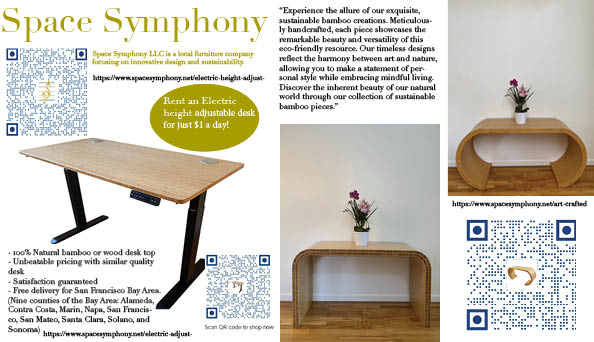
More than 100,000 men and women attended the San Francisco Women’s March on January 21st, chanting and singing amidst a downpour of rain, under a multi-colored canopy of umbrellas and vibrant posters.
This march was among the 673 reported around the world just one day after Donald Trump was sworn in as president, according to The New York Times, all following a movement led by women in Washington DC. The march sought predominantly to advocate for women’s rights, but also to stand in solidarity with the diverse communities in our country, and for the freedom of expression and choice of individuals of all races, religions, ethnicities and sexual orientations, according to the Women’s March on Washington website.
The crowd of 2.5 million people across the world sent a strong signal, organizers said, to the world and our government that the coming years will be unfamiliar territory, the future a time of action and bold change.
The Paly Voice marched alongside the powerful crowd and gathered personal stories of those who felt it necessary to speak up that day.
Scenes from the San Fransisco Women’s March
Locations of sister marches throughout California
The Train
At the Caltrain station on the way to the protest, Palo Altans formed a crowd sporting pink “pussy hats,” a reference to a leaked video of President Trump remark’s towards women and holding bright colored signs. The line for the ticket booth, including this group of reporters for The Paly Voice, stretched to the other side of the station and the ticket dispensers ran out of exact change for the demonstrators. An excited energy of anticipation prickled the air as people stood waiting for the 2:30 p.m. train.
Stanford student Yaelle Viner was one demonstrator wearing a pink hat. She smiled through the cold air as she explained why she found it necessary to partake in the march.
“I have a 6-year-old sister, and granted she is a little young to understand socio-political issues, but I am marching so [that] she is able to see a world as progressive as I have seen in my lifetime,” Viner said.
Her friend, Grace Wallace, stressed the importance of advocating for intersectional feminism, emphasizing that we must remember how limited an individualist viewpoint can be.
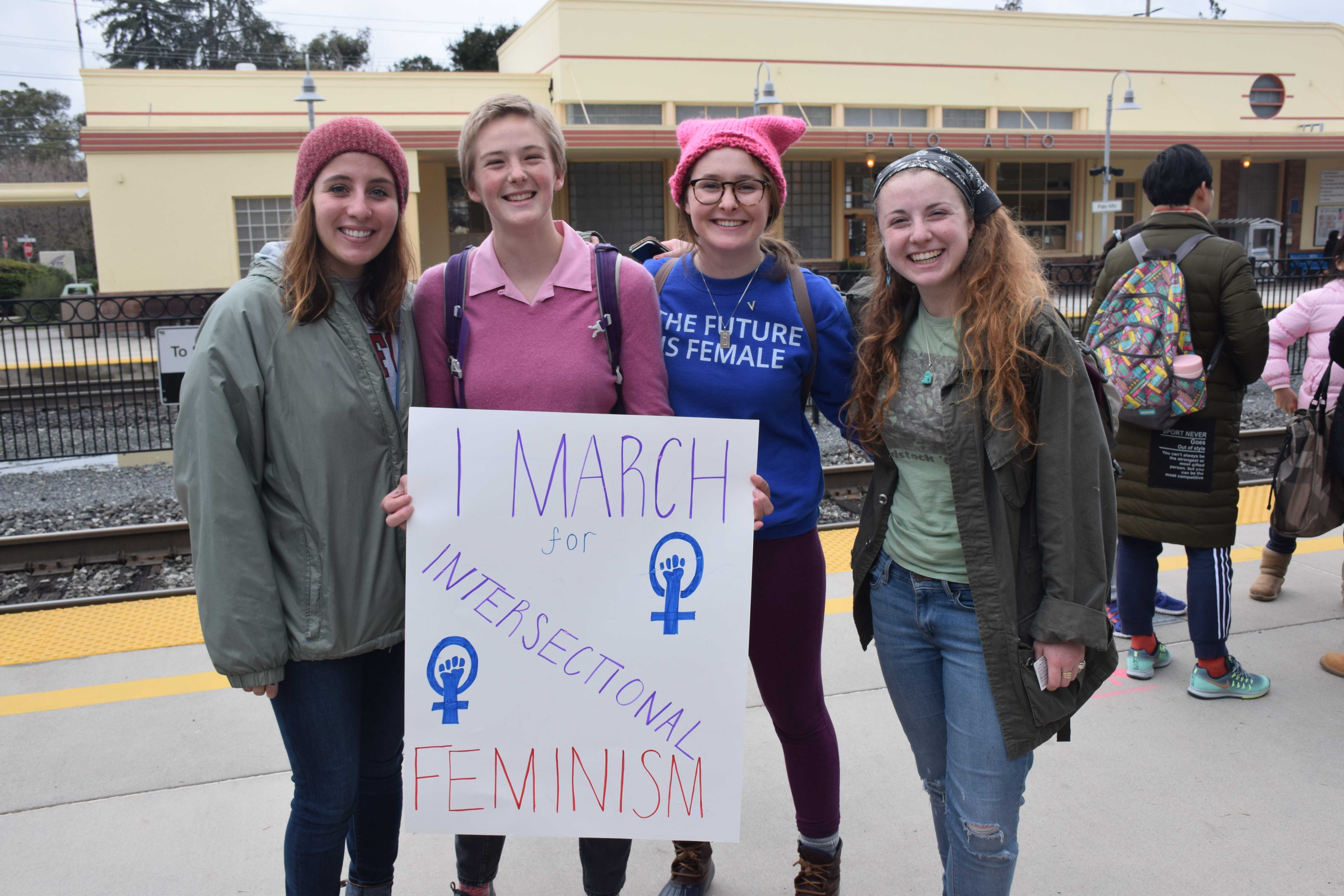
“I am marching to show that feminist causes are intersectional and apply to many different people,” Wallace said. “All of them are equally valid and need to be heard. My sign reads, ‘I march for intersectional feminism’ and then on the back, ‘not open-minded fascism.’ Intersectionality is basically the theory that identities coalesce to form different experiences so that the experience of a white-identifying woman and a black-identifying woman will not be the same and it is important to acknowledge those differences.”
As the train arrived, the demonstrators filled the train-cars past their limit, no seat remained empty, no isle devoid of pink. People clung to the windows and each other, cramped on stairs and in walkways as they made their way into the city.
Bella Gaberal, a Gunn High School senior riding the Caltrain, reflected on the excitement of taking part in a global movement.
“It’s [The protest is] happening worldwide and in many countries,” Gaberal said. “To me it’s just a promise to keep fighting.”
As the journey continued and the train reached the San Francisco station, the lines, between young and old, between the Palo-Altan and the San Francisco natives, between race, gender, ethnicity mingled into a single entity as the crowd bonded in a common purpose.
Emma Rothenburg, protester and college student, grew up surrounded by a powerful female environment. For her, it was important that her mom, her sister and all women and men alike were marching, although separated by miles, together.
“I am marching with my mother and sister — my mother is down in southern California and my sister will be in S.F. so I am joining them,” Rothenburg said. “I was raised by a strong female, who was also raised by another strong female and so on. I know there is nothing a woman can’t do and I want everyone to know that.”

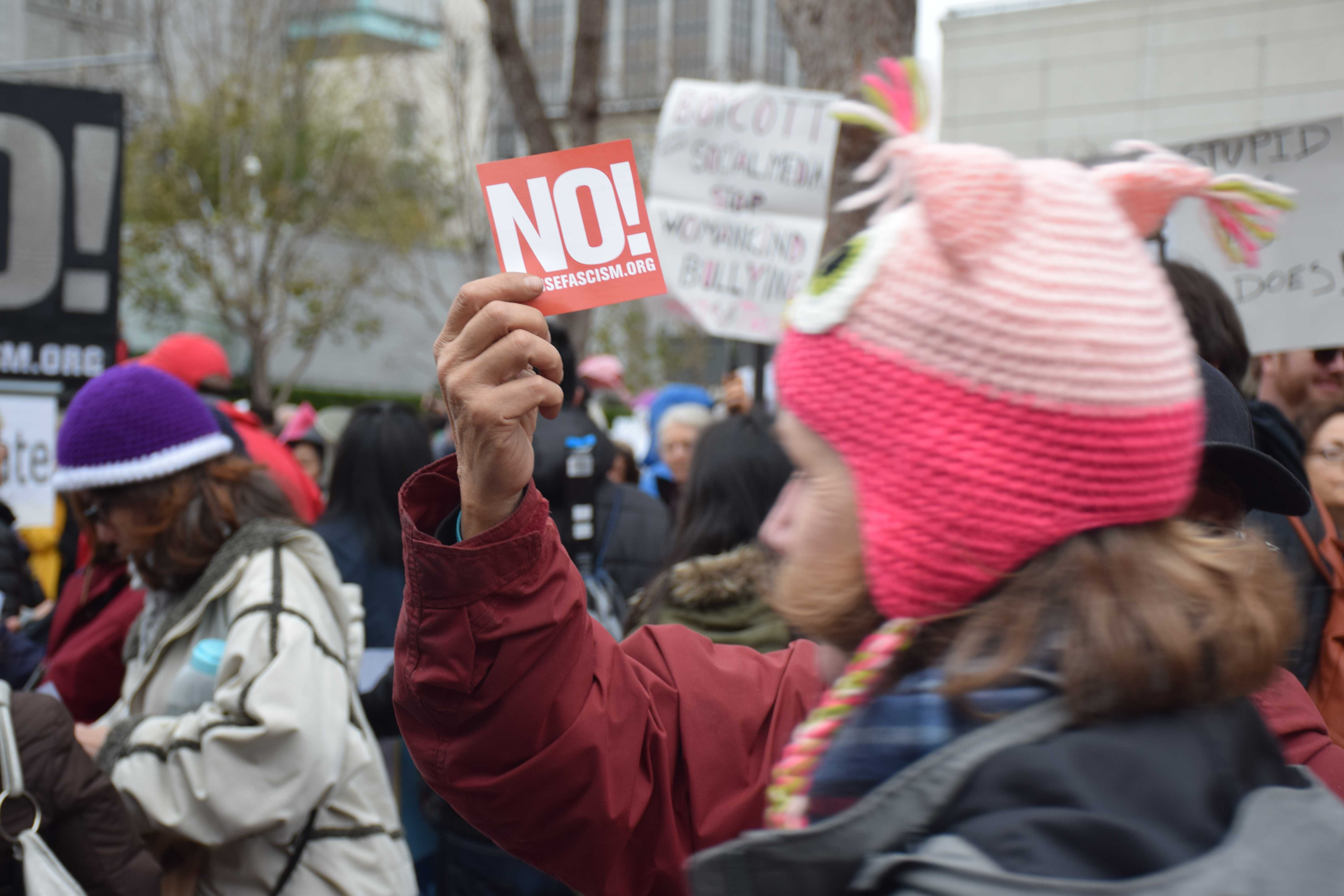
The Rally
The sound of various feminist chants and fierce cheers filled the San Francisco streets as thousands of people stood together, bodies pressed up against each other in solidarity to advocate for equality. Creative signs, reading “keep your rosaries off my ovaries ”and “fight like a girl,” coupled with colorful drawings and designs waved high over the heads of the protestors.

As more and more people joined the rally, rain began to pour down and yet no one dared to move. Instead, they embraced the cold dreary weather in a sort of protest, taking out pink rain jackets and vibrant umbrella’s and craning their necks to listen to Supervisor Jane Kim as she passionately spoke into the microphone insisting that San Francisco has an important role in gender equality and women’s rights. This was followed by speakers making statements about the election and “moving forward.”
As the night moved on, folk singer Joan Baez and queer hip hop artist MicahTron performed, energizing the crowd and moving most to their feet regardless of age. People of all ages, races and genders swayed to the beat of the music becoming one powerful movement in the name of equality and respect.
Paly junior Sofia Muiz says she felt empowered as she passionately rallied the streets of downtown San Francisco with a bright sign reading “equality and liberty, unity in hope.”
“I am marching in solidarity with women in protest of the [man] that just got sworn in, seeing Obama leave on that helicopter might be the saddest moment of my life,” Muiz said. “This man has said so many terrible things to so many wonderful people. I think today we should be working towards equality for all genders, races and creeds and keep fighting.”
Benedito dos Santos, demonstrator and anthropologist, presented a unique viewpoint on the protest. Originally from Brazil and working in a psychology department centered on children’s rights issues, Santos explained in a heavy accent how we must view this march with a broad perspective, going farther than the streets of S.F. and even Washington.
“I decided to come to the march because it is an international movement,” dos Santos said. “There is a conservative movement taking over the country — in Brazil it is also happening. I came to be in solidarity with the Americans, and the Americans against Trump.”
The March
As the rally came to an end, the march began. Thousands of people poured into dark San Francisco streets lit up by red lanterns, the light reflecting off puddles and raindrops still clinging to umbrellas and jackets, that in turn illuminated the streets with a warm flickering glow. Loud chants echoed through the city, voices joining through the soft pattering of rain as the storm subsided.
According to dos Santos, while walking in the rain a special energy took over the crowd.
“Walking, I felt the sensation of coming together, of thousands of people coming together,” dos Santos said. “I like the energy, the energy that comes out of these gatherings. I feel like oh my God, these people, we are talking about the same language. The energy is part of it, it helps us see how people can make a difference.”
“In Brazil,” dos Santos added, “it would probably be louder, with dancing. Here it was very orderly and quiet, but I like the phrases that were said. The number of people was inspiring.”


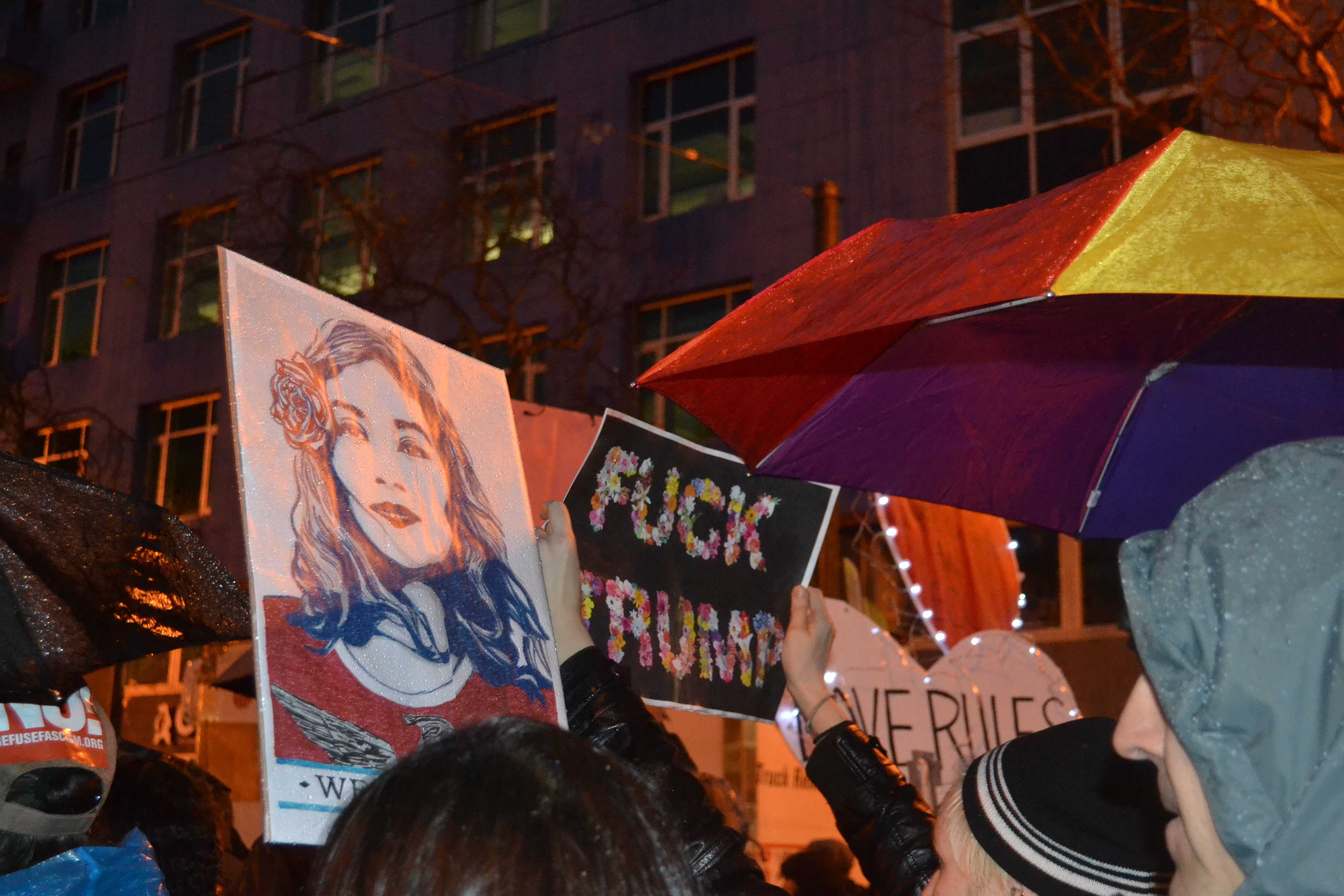

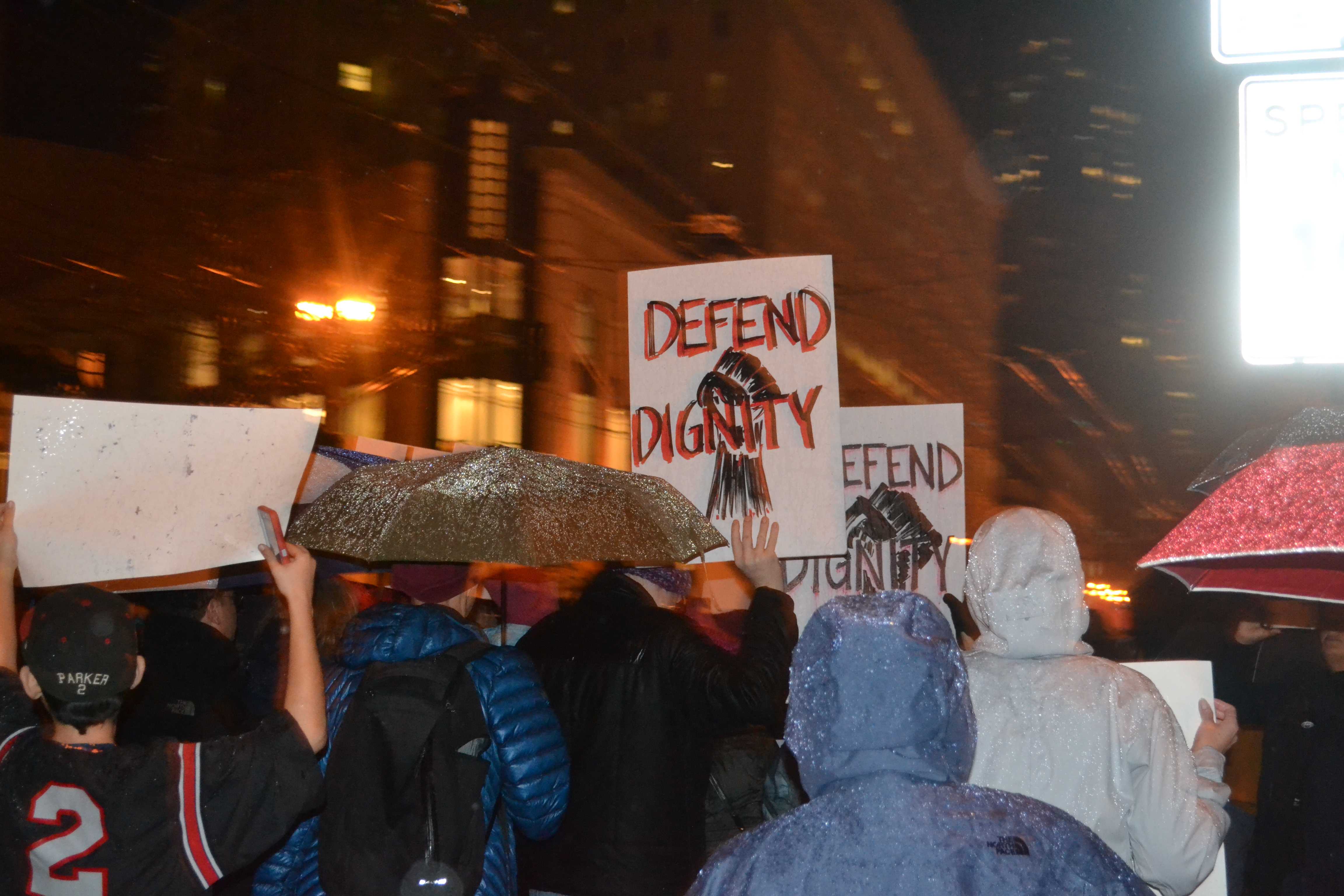
According to dos Santos, this demonstration is not just a release of anger but a necessary way to participate in democracy.
“It [the demonstration’s purpose] is to come to the streets, to say here we are, [to] listen,” dos Santos said “What we do know is that he can bring a lot of damage to the country and we need to think about how to oppose things, He can do a lot of damage to the social movements and to democracy.”
The democratic process is not solely reserved to voting. The First Amendment enables us the constitutional right to peacefully protest against things we feel are unjust and unfair.
Peaceful protest, according to dos Santos, gives personal stories and faces to the people Trump’s presidency will ultimately affect, and the visibility of these people on a global scale can have a large impact on how the government and a people view a situation.
Protest serves to dissolve isolationism, liberating people through a communal sense of “moral indignation,” according to Yale professor Susan Stokes in her research paper “Why Do People Join Backlash Protests?” In other words, instead of coming from an individualist mindset, protest rises from a common sense of moral injustice.
“The one thing that we expect at least is that conservative governments can bring progressive people together,” dos Santos said.
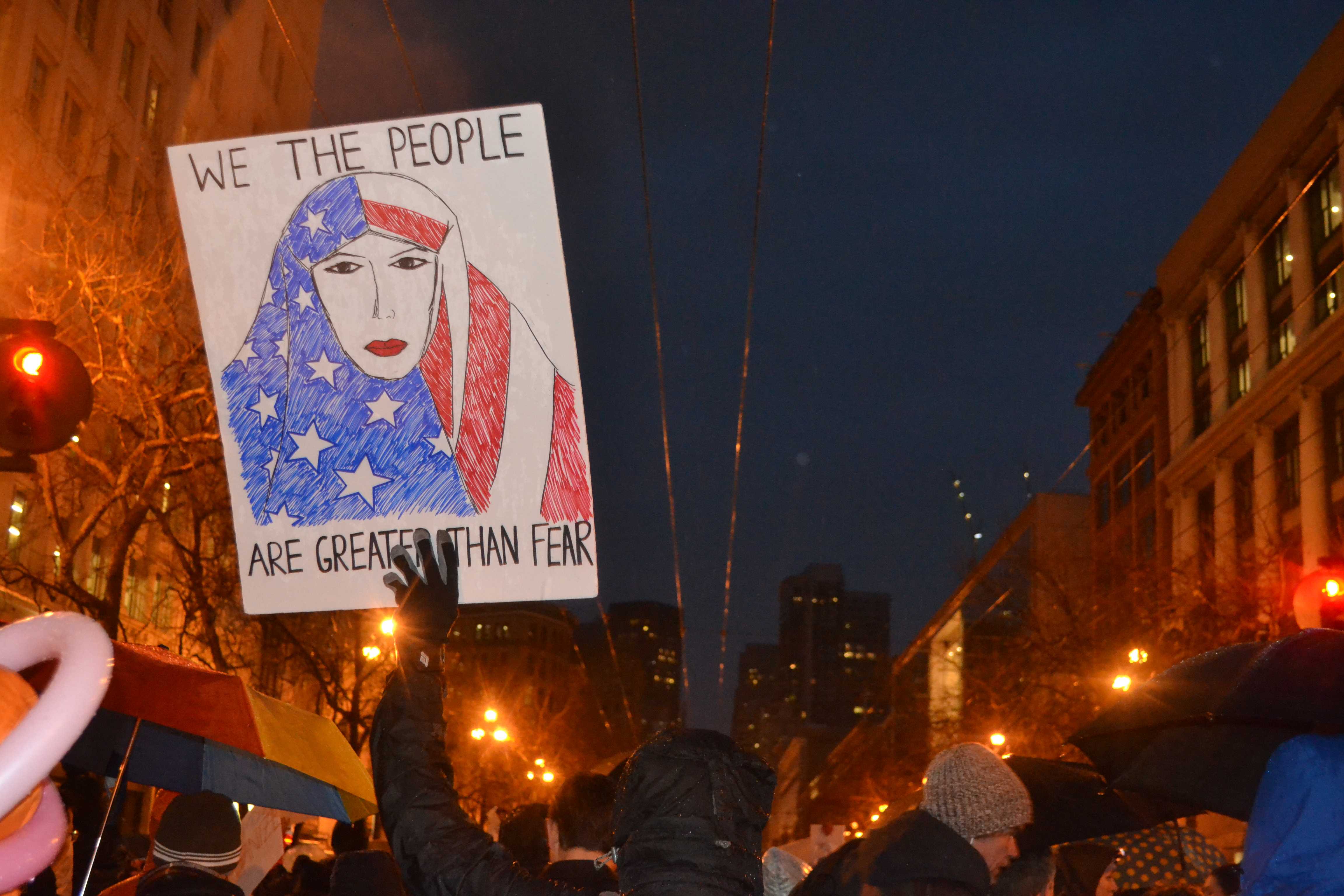
To those who look down on peaceful protest as an ineffective tactic that won’t amount to anything, dos Santos said people should remember that such rhetoric is exactly the kind of thinking that pulls us apart.
“That is going to be Trump’s type of talk,” dos Santos said. “He knows that the visibility of these demonstrations is very powerful. He has to know that he will not be free to do what he wants to do. He has to know that people are going to be watching him, opposing him, and stop him from going backward on what we have achieved so far.”
Moving Forward

The critical question going forward is whether we can sustain the fight when actual policies are initiated, according to dos Santos.
“Coming to the streets and protesting is important, but it is not enough with just one demonstration,” dos Santos said. “The challenge now is to keep us mobilized. Mobilization, permanent mobilization can stop him.”
After exceeding their goal of having millions of men and women march for equality the organizers of the Women’s March have launched a new campaign. To make sure the movement continues, “10 actions in 100 days was created,” outlining a step by step guide to spark change as the presidency continues, according to their website.
According to dos Santos, this next era will be unlike the years of progressive social initiatives that we have been lucky to see happen in the past.
”We have to rethink the way Democrats are making progress, and the way we think about politics,” dos Santos said. “We need to propose new things.”


